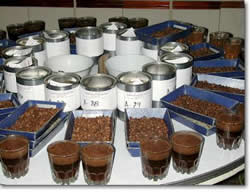
Coffee Blending
Coffee Blending
is necessary for espresso since a single coffee origin will lack
the complexity desired. It is important to remember
that the advantage of espresso over other brewing methods is a result of the formation
of the crema. Without the crema the espresso would
be strong, thick coffee. The crema is an emulsified
layer of tiny, smooth bubbles that trap aromatic compounds.
This layer coats the tongue and these small bubbles break
over time allowing espresso to be enjoyed long after it
has been consumed. An aromatic coffee, therefore,
is essential to a well prepared espresso blend.
The majority of the espresso blend is made up of
a base of coffees from Brazil, the Dominican Republic, Mexico,
Peru, Panama or any other origins that contribute a non-overbearing
flavor while still contributing to the body and sweetness
of the coffee.
Small ratios of coffees from Colombia, Costa
Rica, Guatemala, and Venezuela are used to add body, acidity,
and flavor to a coffee blend. Since these coffees are often
very acidic, they are used in small amounts.
To add complexity and brightness when blending espresso, Ethiopian
Harrar, Kenyan, Yemen Mocha, Zimbabwe, and Zambian coffees
are used. Ethiopian Harrar adds a powerful aroma of
blueberries or raspberries while Kenya coffee adds a powerful
brightness.
To add richness and body when blending for espresso, coffee from the Asian
Pacific, such as Sumatra, Sulawesi, Java, East
Timor, New Guinea
and Ethiopian Yirgacheffe are used. Yirgacheffe has
a potent, flowerlike aroma.
Blending for Espresso Coffee
- Cup each of the coffees separately.
Record aroma, fragrance,
flavor, acidity,
body, and aftertaste.
Cup coffees next to each other to determine which coffees
augment the flavor of another. Remember that
blending coffee beans is an art and there are no clear espresso blending rules. The goal in espresso blending is that the whole must be greater than
the sum of the parts.
- Start with a base of a sweet and heavy
bodied Brazilian coffee(s) and add a small amount of another
coffee to it. Understand the flavor profile of your
base and understand your goal. Ask yourself what
coffees might be added to this base to achieve the espresso blend
you want. Note the change incurred by adding this
coffee and repeat with other coffee origins.
- Next try mixing 3-4 other coffees together
until you get a blend that displays the flavor characteristics
you desire.
- After determining what type of coffee
you would like to use in your espresso blend, begin experimenting with different
ratios until you have determined the best ratios to bring
out the flavor, sweetness, body and aftertaste desired.
- Experiment with different roasts of each
coffee in the blend in the same manner you experimented
with adding other coffees to the Brazilian base.
Roast one coffee a little lighter or darker than the other
coffees in the blend and note any differences. It
is usually preferred to roast each coffee separately to
its own individual peak and then blend coffee to create the most
complexity.
Creating a good espresso blend is not
as difficult as it may initially appear. Within a
few hours you should have an acceptable espresso blend that
will surpass commercial competitors for the simple reason
that it is fresher. To perfect the espresso blend
by altering the roast to achieve the perfect crema, flavor,
acidity, body and aftertaste takes time and patience, but
is a rewarding and educational experience. It is often
difficult to balance the intense acidity of a shot of espresso
which contains a brighter coffee which is used to contribute
complexity and liveliness without roasting through the second
pop. A successful espresso blend, therefore, should balance
this acidity via creative mixing coffee rather than excessive
roasting the beans. Do not roast your espresso past or even
more than half way through the second pop. By not
over roasting, you will preserve the delicate aroma and sugars
in the coffee.
For more information about espresso blending techniques, visit Sweet Maria's or INeedCoffee.com.
Related
Articles
Espresso
Blending by Tom Owen
Coffee
Origins Flavor Overview
Perceived Acidity in Espresso Coffee
Coffee Aftertaste
Espresso Aroma
Espresso Body
Espresso Roasting


